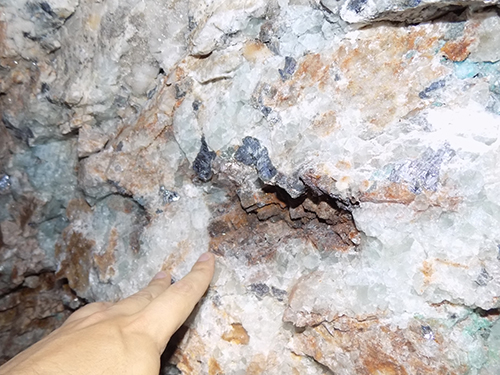
Story and Photos by Mark Leatherman
Anytime a rockhounding club has the privilege of being able to go underground as part of an extended field trip, the participants are in for a definite treat. When I first heard of such a trip being planned, thanks to Gary Rowe of the Colorado Mineral Society (CMS), I knew I had to clear my calendar and save up provisions! Our trip would be centered on the town of Socorro, New Mexico. It would extend over two full days, and would easily become one of my most favorite treks ever, in terms of both the variety of minerals to collect and the fun and interesting memories.
My seven-and-a-half-hour solo trek from Denver to Socorro, heading north on Interstate 25, almost ended before it began! The Denver area was caught in a mid-May blizzard, which made the first two hours of driving very perilous and nearly made me turn back. Like a tortoise, I inched my way along until the snow turned to light rain around Colorado Springs. Between Colorado Springs and Pueblo, it was sunny as could be. As I went through Pueblo, it was precipitating dime-size hail. From Pueblo on out, there was not a cloud in the sky. Talk about Mother Nature’s ever-changing moods!
The Kelly Mine
The next morning, our first full day of the venture started with meeting five other CMS members in a restaurant parking lot. We carpooled to Tony’s Rock Shop, in the village of Magdalena, a 30-minute drive west along U.S. Highway 60 from Socorro. Bennie, the shop owner, greeted us. We paid our $10-per-person entrance fee, received maps of the mine area, and had a chance to glance over some impressive smithsonites and other mineral specimens for sale. The rules for collecting at the Kelly mine were simple: Don’t venture down any old mine shafts and be off the premises by sundown.
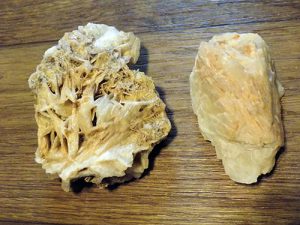
From Tony’s, it was only a three-mile drive southeast to the mine entrance gate. St. John the Baptist Catholic Church is very close by. Collectors could park at the church or try to venture into the mining grounds proper, which required a high-clearance vehicle. I rode in with a new friend, Chris, since a Jeep Rubicon would best a Ford Focus anytime!
The Kelly mine is in the Magdalena mining district, which started extracting ore in 1878 and continued to do so until the last residents moved out in 1947. The actual mine site is technically situated in Kelly, a ghost town named after claimholder Patrick H. Kelly. In 1884, it was a boomtown, with general stores, banks, saloons, churches, and mine company houses. The mine’s heyday was in the 1910s, when it was the state’s leading producer of lead and zinc.
Formations Speak Volumes of Geological History
Geologically speaking, this mining district is in the Magdalena Mountain Range, classified as fault-block mountains. This variety of mountains forms from crustal extension, in which the ground splits apart at a fault and large blocks of crust either drop down or are thrust up. The sunken areas are known as basins, and the pushed-up blocks are characterized by sheer rock faces on one side and gentle slopes on the other. The region of crustal spreading occurring in New Mexico is known as the Rio Grande Rift. The faults would later serve as conduits for mineral-bearing fluids.
Before the onset of crustal rifting, Mississippian-age fossiliferous limestone was deposited on top of a Precambrian-age igneous and sedimentary rock sequence, in the shallow, warm oceans that covered the area. These rocks became known as the Kelly limestone, and would serve as the main ore-bearing unit. Deposited on top of the Kelly limestone are sandstones and other limestones. Following the Permian Period (around 250 mya), multiple granitic magmas intruded the area and solidified.
Hydrothermal fluids initially altered and replaced the initial Kelly limestone into harder silicified limestone. After this, the fluids deposited the primary ore minerals (galena, chalcopyrite, pyrite, sphalerite) into the Kelly limestone, mainly, but some mineralization is hosted in the underlying Precambrian rocks, as well. A short time after the main mineralizing event, sphalerite and galena were oxidized to form the respective secondary carbonates of smithsonite and cerussite. Some malachite and azurite, are also formed from the oxidation of chalcopyrite.
Common and Uncommon Specimens
The most noteworthy smithsonite specimens found here have a distinctive blue-green hue, with other wonderful shades of apple green and steely gray-blue. Additionally, their distinctive botryoidal crystal form easily sets them apart from other minerals. The galena and pyrites I have found here are mostly anhedral in overall crystal form. Some freshly broken ore boulders can reveal subhedral cubic cleavage planes, but I have not found any protruding 3-D cubes here. The malachite and azurite I have found here were mostly just small encrustations. However, one club member showed off quite the azurite find from a few years back—a set of elongate prismatic navy blue crystals—so there is always a chance!
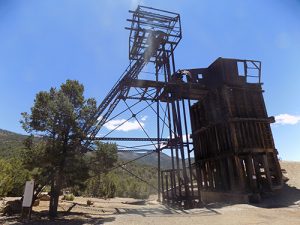
The Kelly mine area is divided up into multiple distinct tailings piles. While there is always a chance of finding smithsonite at any pile, certain piles will be better than others as sources of certain combinations of specimens. The mine area maps and permits will highlight the piles and tell which minerals are most likely to be found in each.
I started my day at the pile closest to where we parked, surrounded by loads of collapsed wood, while much of the group started at a neighboring pit. Given the number of visitors the Kelly mine receives, finding even a small, good smithsonite is far from a guarantee. Luckily for me, it only took about 45 minutes to find my first one—a small cluster of sea-green crystals in a silicified vug—about 10 yards from where I started.
After hammering on some boulders to see if I would get lucky with hidden massive sulfide ore, I made my way toward the neighboring pit to show off my first find. Nobody else had found any smithsonites yet, but Chris had recovered two matching halves of a boulder saturated with galena.
Tales From the Dig Site
I plucked up two more of the zinc carbonates, this time with steely blue-gray hues, within just a few minutes of each other. Upon hearing my expressions of glee, a club member exclaimed to me, “You rat!” She had previously walked over the same spot.
Strolling around the rest of the grounds, one can easily place oneself in the historical days of active mining, as the main hoist shaft, smelter, housing, rusted hardware, and other dilapidated infrastructure are still on full display. Although properly surrounded by fencing, the vertical shaft is still open, and you can still have a partial peek down. In seeing this, I had a brief nerd moment in which I dropped a pebble, or two, down and counting the seconds until I heard its impact (and figuring out the distance traveled due to gravitational acceleration).
Make Shop Stops Part of Road Trip
After finding six decent smithsonites, several ore specimens, and a bonus crinoid stem fossil, I decided to call it a wrap in mid-afternoon, so I would have some time to get back to Socorro and visit New Mexico Tech’s mineral museum. The small group that I had started my day with was still in the initial pit. Kyle had found a trio of very nice, but quite small, apple-green smithsonites (the largest was around an inch long) by digging into the slope and screening the dirt. A few other clubmates had made their way down to our location from the surrounding hills, having had some luck around some smaller, collapsed mine portals.
On my way out of Magdalena, I stopped into another rock shop called Otero’s, at 105 E.
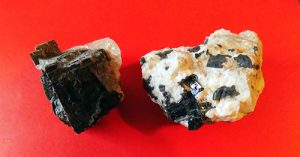
First Street. The shop owner, Ben (actually a relative of Bennie’s), was quite inviting and regaled me with stories of collecting at the Kelly mine before it became heavily picked over. Along with an impressive collection of smithsonites, Ben showed off probably the most impressive set of zinc carbonate jewelry one can lay one’s eyes upon. Along with an array of individual types of jewelry, Ben has crafted the only trio of complete smithsonite cabochon and sterling silver jewelry sets (necklace, bracelet, ring and earrings). Each set is worth around $2,000.
Due to their rarity, the lowest-end jewelry pieces start in the hundreds of dollars and can easily reach four figures. If one is interested in making a custom piece of smithsonite jewelry, Otero’s is the place to go! The shop’s phone number is (575) 740-4996.
The Blanchard Mine
The next day’s stop was considered the “main event” for this club trip, and for very good reason. We met up with a considerably larger group at the Blanchard Rock Shop, in the “town” of Bingham. A number of repeat visitors said that this particular stop is their favorite all year ’round.
From my Socorro motel, I drove south on I-25 for a few minutes to Exit 139, then took U.S. Highway 380 east for 30 miles. Signs for the rock shop absolutely cannot be missed, and it is one of the only buildings out in the open desert. I was one of the first to arrive, so I had some time to chat with the shop owner, Allison, peruse the massive inventory of bulk rock displayed outside, and make friends with the shop mascot, “Momma Kitty”, a very social orange tabby cat, as well as two German Shepard guard dogs.
Ray DeMark, the Blanchard mine claim owner, gave out area maps, and we caravanned due south down a nearby dirt road. After driving for around 3.5 miles, watching out for loose cattle, we stopped to get a wonderful panoramic view of the Blanchard mine on the distant hillside. Ray talked about the general geology of the mining district, and pointed out other nearby claim sites.
The Blanchard mine is just one of a few dozen discovered mines that comprise the larger Hansonburg mining district. In turn, the Hansonburg is the largest district that is located wholly within the Rio Grande Rift. The key minerals that are found at these mines are fluorite, galena, barite, brochantite, anglesite and linarite. Other minerals include cerussite, gypsum, calcite, caledonite, cuprite, hemimorphite, hydrozincite, smithsonite and wulfenite. It is literally impossible for anyone to walk away from the Blanchard empty-handed!
Fault-Block History
The geologic story of the Hansonburg district starts with the Sierra Oscura Mountains, and is very similar in scope to that of the Magdalena district. The Sierra Oscuras are also fault-block mountains, initiated by the same Miocene crustal-thinning episode. The main rock units here are also mostly the same: Proterozoic granites and gneisses comprising the base (or basement), with Pennsylvanian-age sandstones, limestones and shales. The Kelly Formation (ore host) counterpart here is called the Madera Limestone, which also underwent silicification into a much harder body. Hydrothermal fluid activity dissolved portions of the limestone to create cavities.
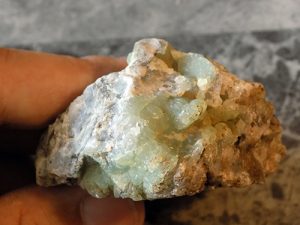
The fluids are thought to have been composed, in part, of hydrofluoric acid (HF), as evidenced by the presence of fluorite (CaF2). The dissolution cavities, along with fault creation from the tectonic stretching, served once again as the avenues for hydrothermal mineralization. The Blanchard fluorites are shades of blue, green and purple, or clear. Along with the traditional cubic crystals, specimens display a rounded, stepped habit, indicative of rapid crystal growth along the edges.
Fluorite is a personal favorite, and I zeroed in on finding the dark-blue hue (also known as “Bingham blue”), which is caused by light interacting with an electron that is housed in a vacant fluorine site in the cubic crystal structure. If sufficient energy (i.e., ultraviolet light from the sun) is present, dislodged fluorine atoms can return to their original site in the crystal lattice. This removes the free electron, and its associated color wavelength. Therefore, the Bingham blue color will fade over time with prolonged sunlight exposure.
Appeal of Linarite
Collectively, the most sought after mineral on this venture was the royal-blue linarite. It is a semi-rare mineral that is prized for its intense hue and its patches of small, acicular crystals. Linarite is a secondary copper mineral with a very similar appearance to azurite that also contains lead (PbCuSO4(OH)2). The two blues can be distinguished in that azurite reacts to weak hydrochloric acid, whereas linarite will not. Linarite’s more common emerald-green counterpart is the secondary mineral brochantite (Cu4SO4(OH)6). As with the “blues brothers”, brochantite can easily be confused with its more common cousin, malachite. Again, malachite reacts with acid, whereas brochantite will not. In most specimens that contain both linarite and brochantite, the former is present in lesser amounts due to its slightly more complex chemical formula.
After our geology talk, the caravan proceeded another two miles or so to a parking area marked with cement slabs. There, we assembled into carpools, since this was the end of the “smooth” portion of the trek up. From this spot, most of the old mine ground’s infrastructure was visible, and Ray gave another short talk on the production history and how ore was processed and transported. The first significant mining activity here was for lead in 1916, with operations being run by Western Mineral Products.
Throughout the next 50 years, lease ownership changed hands quite a few times, and production was extremely limited, due to the high difficulty in separating the galena from the barite and fluorite. The current owners, of whom Ray is one, purchased the claim in April 1987, and it has been worked exclusively as a specimen mine ever since.
We proceeded a short but harrowing distance upward toward a bench in the middle of the mountain slope. The path up is narrow and rocky, with switchbacks. We did our best to cram all our vehicles into the limited parking area in an orderly fashion. This middle bench is one of two main levels for rockhounding, and consists of a short, linear path along the mountain slope. While walking around to get acclimated, the group noted that pieces of clear and light-purple fluorite, brochantite, and partially oxidized galena were plentiful.
Be Aware of Surroundings
We were instructed which were the best, safest places along the bench wall for hammering out specimens. This is the smallest area in which to exclusively surface collect, and it is highlighted by a relic wooden ore bin.
After being told to watch for rattlesnakes, we returned to our vehicles and continued
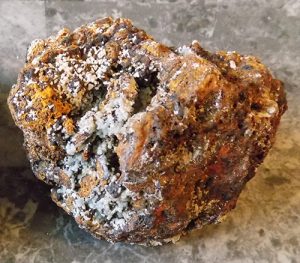
upward another short distance toward the highest (primary) level of the mine grounds. The parking area up there is significantly larger, and the views of the horizon from the cliff face are worthy of some snapshots.
We wasted no time in sorting our equipment and made a beeline for the mine opening in the wall rock. After equipping our headlamps, Ray demonstrated the preferred method of fitting through the 3-foot by 3-foot underground mine portal. It involves leading with one leg, placing the foot on a ladder rung, followed by moving butt first, and ending by poking your head in. After everyone made it underground, Ray gave us a short walkthrough of the mine layout and showed us where to find certain specimens.
Again, it was impossible to walk out empty-handed! The easiest specimens to collect here are galena interspersed in snow-white quartz and barite, as they are lying everywhere for the picking, as well as on the walls and ceiling. I knew I was in a rockhound’s heaven! Along with a good part of the group, I started in one of two spots that, according to Ray, had the best chances of holding linarite. As I was getting into my first subhorizontal position, my senses were almost immediately overloaded by the selection of specimens to start chiseling out! I saw brochantite, euhedral quartz crystals, light-green, “hopper-faced” fluorite, galena, barite, anglesite, and traces of linarite all in the same spot.
Challenging Chiseling
However, the Blanchard mine does not give up its treasures quite so easily! As mentioned before, the host rock is very hard silicified limestone that will put even the most eager rockhound’s endurance to the test. I started out by chiseling away at a few pre-existing fractures to get some small specimens, while Kyle and a couple others started to advance a small tunnel that had already been started by Ray. It did not take long for Kyle to produce foot-long plates covered with royal-blue blotches.
We had a time limit of around three hours underground before Ray summoned all of us to close shop for the day. When we reconvened at the parking lot, Ray was kind enough to pull out several flats of exceptional specimens from his van and offer them for sale. Although I thought I fared well on the linarite front, I nonetheless decided to buy a $15 linarite cluster.
For the remainder of the day, I joined up with Nancy and Bob Hatfield to try our luck in mining blue fluorite from a surface vein that they had found the year before. We headed up to the middle of a slope about 50 yards south of the underground portals. The three of us alternated between working the slope, and exploring the surroundings for surface boulders.
This area has plentiful, large specimens of calcite, barite and fluorite, just ripe for the picking. It seemed that the loose surface boulders contain mainly colorless, light-purple, and light-blue fluorite, whereas the darker “electric-blue” fluorite is in the hillside pockets (as well as underground). When it was my turn to work the slope-side vein, I did my best to keep track of my time on it to be fair to the others. In all, I managed to pull out a few loose blue cubes.
Not even two minutes had passed since I had passed my turn over to Bob, when he pulled out two small, but miraculous, deep-blue clusters. Since I had just missed them, Bob offered both to me. I compromised, and each of us took one cluster. We kept on surface digging until we called it a successful day at around 6:30 pm. Most of us would be heading back to the Denver area the next morning. A few others, including Kyle, camped out at the mining grounds for an extra day’s worth of underground mining, while another few would try their luck again with finding smithsonite.
Desert Rose Claims
If you’re interested in rockhounding the Hansonburg district, your best chance will probably be to visit the Desert Rose Claims, where both individuals and groups can collect. The claims are in the same region as the Blanchard mine and the same minerals (including linarite) can be found. The only major difference is that the Desert Rose is restricted to surface collecting. For a fee of $20 per person, visitors are allowed to carry out a maximum of 20 pounds of material (depending on quality).

To arrange a visit to the Desert Rose, call Allison or her husband, Donnie, at the Blanchard Rock Shop, at (575) 423-3235, or e-mail them from their website www.blanchardrockshop.com. Be sure to check out Allison’s selection of trinitite, glass fused together by the atomic bomb tests conducted at the Trinity Site, in the same region.
Access to underground collecting at the Blanchard mine is restricted to several regional clubs. However, the day before the Socorro Mineral Symposium, held every November, Ray holds an open house at the Blanchard, which anyone can attend. The only requirement for entry is that you are registered for the symposium. Information on the symposium can be found at https://geoinfo.nmt.edu/museum/minsymp/. The symposium is a wonderful chance for any professional or amateur rockhound/geologist to enhance and share their knowledge!















